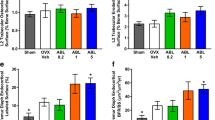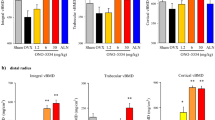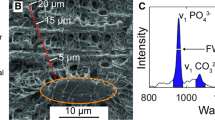Abstract:
The goal of this study was to determine the effects of chronically elevated blood androstenedione and estrone levels on the quality and quantity of both cancellous (trabecular) and cortical bone in a young (mean age 9.4 years) female primate model (M. fascicularis). Thirteen intact female monkeys received continuous androstenedione/estrone supplementation via subcutaneous implants over a 24-month period to simulate the human condition known as polycystic ovarian disease (PCOD). A group of 16 untreated intact age-matched female monkeys served as controls. Lumbar spine and whole body bone mineral density (BMD) status was determined mid-study by dual photon absorptiometry (DPA); subsequent analysis of the bone related to data obtained following the 2-year treatment period without further BMD measurement. Bone markers, including serum acid phosphatase, total bone alkaline phosphatase, bone gla protein and tartrate-resistant acid phosphatase were measured at the end of the study. At necropsy, the lumbar vertebrae and femora were recovered in order to analyze the bone mineral quality and quantity of cancellous and cortical bone respectively and to compare these with the control group. Mineralization profiles of the vertebrae and femora were obtained using the density fractionation technique. Chemical analysis of the three largest fractions retrieved by density fractionation was performed to evaluate differences in %Ca, %P, Ca/P ratio and mineral content (%Ca+%PO4) between control and experimental groups. In addition, unfractionated bone powder was examined by X-ray diffraction to identify any changes in crystal size. Coronal sections of vertebrae were analyzed for structural parameters using histomorphometry and image analysis. Cross-sections taken at the midshaft diaphyseal femora were analyzed for structural macroscopic and intracortical parameters. There was a significant increase in BMD at the L2–L4 region in the treatment group compared with the control groups (p<0.005) as measured at 1 year into the trial. Serum acid phosphatase was significantly lower (p<0.05) in the treatment group compared with the controls near study termination. A nonsignificant shift in the mineralization profile of the vertebrae towards less dense bone was observed in the treatment group, while there was a significant shift in the mineralization profile towards more dense bone in the treated femora compared with controls (p<0.05) after a 2-year period. There was no difference between treatment and control groups in terms of size/strain of the cortical or cancellous bone crystal as detected by X-ray diffraction. There was a significant increase in cancellous bone area (B.Ar.) (p<0.02) and a significant increase (p<0.05) in mean trabecular width with a corresponding decrease in trabecular separation (p<0.03) in the experimental group compared with the controls. There were no significant changes in osteoid parameters (perimeter, area or width) or eroded perimeter measurements in the experimental group compared with the controls. In the experimental group, trabecular strut analysis showed a significant increase in the number of nodes (p<0.02) and in the total strut length (p<0.003) compared with the controls. There was also a significant increase in the node to node (p<0.04) and node to terminus (p<0.004) strut length in the treatment group compared with the controls. A significant increase in B.Ar. without concurrent indices of ongoing remodeling differing from controls suggests that cancellous bone of the vertebral body in the treated young female primate had been receptive to the anabolic stimulus of androstenedione/estrone supplementation over the 2-year period. In contrast, macroscopic parameters of cortical bone such as perimeter, area and width were preserved over the 2-year course, while intracortical remodeling was evident with increased percent porosity (p<0.001), osteonal bone (p<0.01) and osteonal density (p<0.01) observed in the treatment group compared with the controls. The endocrine profile of both elevated androstenedione and estrone levels in an intact female primate of reproductive age may identify differential effects of the condition known as polycystic ovarian disease on the skeletal compartments.
Similar content being viewed by others
Author information
Authors and Affiliations
Additional information
Received: 24 November 1999 / Accepted: 4 April 2000
Rights and permissions
About this article
Cite this article
Lundon, K., Jayo, M., Register, T. et al. The Effect of Androstenedione/Estrone Supplementation on Cortical and Cancellous Bone in the Young Intact Female Monkey: A Model for the Effects of Polycystic Ovarian Disease on the Skeleton?. Osteoporos Int 11, 778–789 (2000). https://doi.org/10.1007/s001980070057
Issue Date:
DOI: https://doi.org/10.1007/s001980070057




